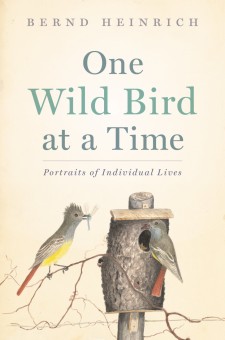Reviewed by Grant McCreary on July 24th, 2017.
Birding vicariously. That seems to be the aim of a good bit of birding literature. We, the reader, get to tag along on wild expeditions to discover new birds or frenetic wanderings to see as many birds as possible in a year. Don’t get me wrong, I love it. As much as I’d love to, I know I’m not able to do a big year right now, or even take a month off to trek about the jungle, so reading about it is the next best thing. At first glance, One Wild Bird at a Time: Portraits of Individual Lives doesn’t seem to share much in common with such books. It is more restrained, in both aspiration and geography. But it, too, is vicarious birding that is just as much, if not more, satisfying.
One Wild Bird at a Time is a collection of 17 unrelated chapters, each focusing on a particular bird – not a certain species as much as specific, individual birds. These are birds Heinrich encounters around his New England homes, such as Barred Owl, Great Crested Flycatcher, and Blue Jay. He is able to follow them around, watch them, and really get to know them.
In the process, he learns lots of cool things about these birds. A pair of Broad-winged Hawks, for instance, lined their nest with fresh fern fronds and replenished them almost daily until their chick fledged. After considering several explanations, he comes to the conclusion that it likely serves as a sort of “tablecloth”, a “clean substrate” that helps keep the nest hygienic. In another case, while observing a Blue-headed Vireo nest, he found that the birds seemed to remove eggs from their own nest. He hypothesizes that it is a form of voluntary brood reduction in response to the dismal weather.
Ok, these aren’t earth-shattering revelations. But in several cases Heinrich observes behavior unreported previously. And even in cases where he doesn’t witness anything new, there is still value in observing and questioning, for “common knowledge is often worth examining.” But the real value here is not the knowledge itself, but how it was attained.
I was absolutely floored by what Heinrich had to do to make these observations. To see what he did required extreme dedication. He needed the discipline to make repeated observations, sometimes meaning daily 5 km hikes through the Maine woods. In winter. It required diligence in note taking, even when it got tedious for him. He displayed remarkable ingenuity in figuring out what, exactly, these birds were doing. And underlying all of this is his intense curiosity, a burning need to understand what is going on around him.
I wish I could do the same. But I don’t have the time or opportunity. That’s what I tell myself, anyway. But while I may not have the time to make repeated, extended observations like the author, I can pay more attention to whatever birds are around me. And until I’m able to make my own, I can share in Heinrich’s discoveries by reading his words.
Recommendation
A reading of One Wild Bird at a Time: Portraits of Individual Lives will teach you many things about a small selection of eastern North American birds. But the most important things you will get out of this book are the reminder that birds are individuals and the realization that there is much more to discover, even about our most common birds, and that anyone can do so. As Heinrich relates:
I watched and learned [from watching a woodcock as a child], with no theory to prove. And now, sixty years later, I’m still learning by being an audience to a woodcock, and so can anyone learn by watching a starling, a sapsucker, a flicker, or a house sparrow – one wild bird at a time.
Disclosure: I get a small commission for purchases made through links in this post.
Buy from NHBS
(based in the U.K.)
Disclosure: The item reviewed here was a complementary review copy provided by the publisher. But the opinion expressed here is my own, it has not been influenced in any way.




Comment